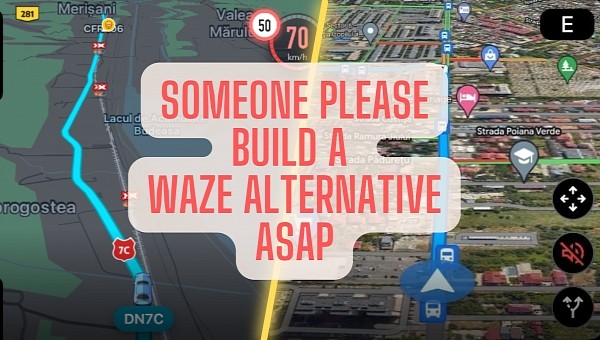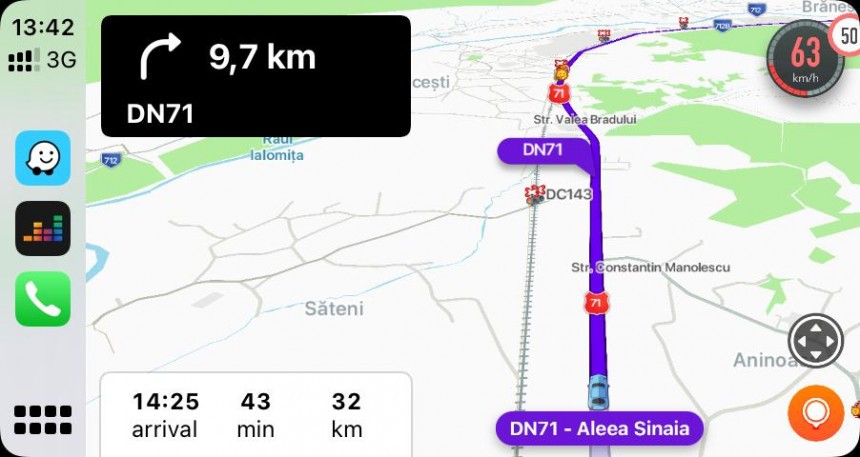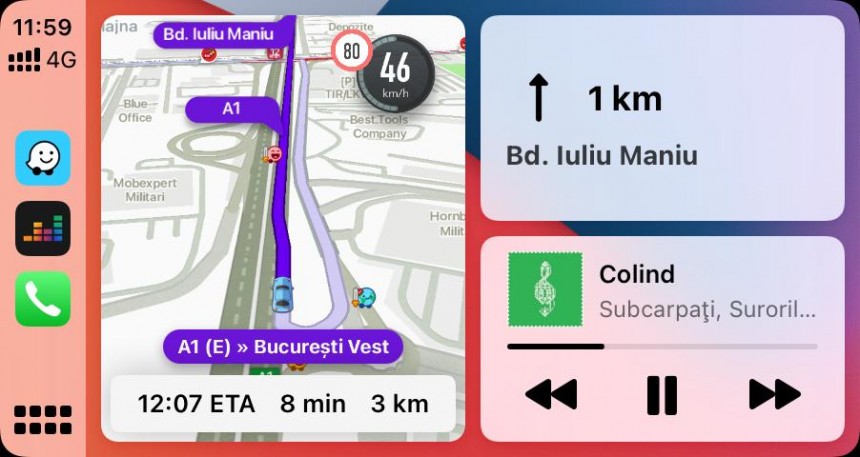You’d think that finding an alternative to Waze is pretty easy in 2023, but anyone who checks out the navigation space closely should immediately understand this is nearly impossible.
Unlike other navigation apps, Waze comes with something that seems extremely challenging to build, including for tech giants like Apple. The crowdsourcing engine powering its traffic reporting system allows Waze to know precisely where you’re expected to come across slowdowns.
As such, Waze’s routing model can avoid these regions, and in almost every single case, provide you with a faster way to reach the destination.
This doesn’t necessarily mean that Waze is a perfect app. This is the reason I stopped using it, hoping I’d eventually find another navigation app able to help me deal with heavy traffic during my commute.
The main thing that pushed me to alternative navigation software was the overall instability of the app. I ran Waze on CarPlay, and the app has always felt like a work in progress, with occasional glitches breaking down the route guidance or the GPS location tracking.
In some cases, Waze ended up breaking down CarPlay entirely, causing the audio controls to no longer work when the app was running.
Obviously, most of these problems have been resolved eventually, but using Waze feels like a crazy rollercoaster ride. What works today can be broken tomorrow, even without changing anything on your side.
Second of all, the cartoonish interface is driving me nuts. Long-time users certainly know the Google-owned company has been sticking with the same approach for years. Eventually, the current look makes Waze, especially when compared to Google Maps and Apple Maps, feel like software designed for kids. As a matter of fact, an important update for Waze is already in the works internally, but in its current version, it’s not a dramatic facelift of the current interface.
Third, the Waze team doesn’t seem very committed to bringing new features to users. Features like warnings for speed bumps, a trip summary, and school zones have been among the top requests for years, and yet, they are still nowhere to be seen. In many ways, Waze is slowly feeling outdated, and without a UI refresh and new features, I wouldn’t be surprised to see more users jumping ship.
However, I rapidly figured out the hard way that Google Maps is no Waze replacement. It does have a series of extras, such as offline maps, but I typically drive in a city with a permanent data connection, so this feature makes no difference.
Google Maps uses a model similar to Waze and collects traffic data from users' devices. Additionally, it imports data from Waze, such as the location of accidents.
But despite this approach, Google Maps isn’t by any means as accurate as Waze when it comes to finding the fastest route to a destination and helping you avoid traffic jams. Google Maps seems to favor more convenient driving, so instead of sending you to secondary streets, the application keeps you on main roads where you are more likely to encounter bumper-to-bumper traffic.
At the same time, the absence of traffic reports feels, well, like a trip in the past, after several years of using Waze. Google Maps also comes with a basic implementation of traffic reports, but few people I know are even aware it exists. Waze, on the other hand, supports a wide variety of traffic reports, from traffic jams and accidents to speed traps, broken traffic lights, and roadkill.
One of the main roles of traffic reports is to make every journey more predictable, as you always know what to expect when you approach a certain location. Once again, the huge community that powers Waze makes a huge difference.
Several other companies have tried to copy this approach, but nobody managed to build a solution that’s as advanced and widely adopted as Waze. Apple Maps, for instance, also sports traffic reports, but the feature is limited to speed checks, accidents, and other hazards. It’s mainly used in the United States, but even so, I rarely came across a traffic report on Apple Maps. This is a sign Apple Maps lacks the active community I was talking about. Apple Maps does have a gigantic user base, but for now, its contribution in terms of traffic reports is very limited.
Other applications, such as Sygic GPS Navigation, Coyote, and TomTom’s software are based on a Waze-inspired model for traffic reports, but they either lack the community power to make this feature work or come with a subscription-based model.
As such, Waze’s routing model can avoid these regions, and in almost every single case, provide you with a faster way to reach the destination.
This doesn’t necessarily mean that Waze is a perfect app. This is the reason I stopped using it, hoping I’d eventually find another navigation app able to help me deal with heavy traffic during my commute.
Why I stopped using Waze
First of all, here’s why I gave up on Waze after many years of using it nearly daily.The main thing that pushed me to alternative navigation software was the overall instability of the app. I ran Waze on CarPlay, and the app has always felt like a work in progress, with occasional glitches breaking down the route guidance or the GPS location tracking.
In some cases, Waze ended up breaking down CarPlay entirely, causing the audio controls to no longer work when the app was running.
Second of all, the cartoonish interface is driving me nuts. Long-time users certainly know the Google-owned company has been sticking with the same approach for years. Eventually, the current look makes Waze, especially when compared to Google Maps and Apple Maps, feel like software designed for kids. As a matter of fact, an important update for Waze is already in the works internally, but in its current version, it’s not a dramatic facelift of the current interface.
Third, the Waze team doesn’t seem very committed to bringing new features to users. Features like warnings for speed bumps, a trip summary, and school zones have been among the top requests for years, and yet, they are still nowhere to be seen. In many ways, Waze is slowly feeling outdated, and without a UI refresh and new features, I wouldn’t be surprised to see more users jumping ship.
Google Maps is no Waze replacement
After I decided to give up on Waze, my first stop was obviously Google Maps.However, I rapidly figured out the hard way that Google Maps is no Waze replacement. It does have a series of extras, such as offline maps, but I typically drive in a city with a permanent data connection, so this feature makes no difference.
Google Maps uses a model similar to Waze and collects traffic data from users' devices. Additionally, it imports data from Waze, such as the location of accidents.
But despite this approach, Google Maps isn’t by any means as accurate as Waze when it comes to finding the fastest route to a destination and helping you avoid traffic jams. Google Maps seems to favor more convenient driving, so instead of sending you to secondary streets, the application keeps you on main roads where you are more likely to encounter bumper-to-bumper traffic.
One of the main roles of traffic reports is to make every journey more predictable, as you always know what to expect when you approach a certain location. Once again, the huge community that powers Waze makes a huge difference.
Several other companies have tried to copy this approach, but nobody managed to build a solution that’s as advanced and widely adopted as Waze. Apple Maps, for instance, also sports traffic reports, but the feature is limited to speed checks, accidents, and other hazards. It’s mainly used in the United States, but even so, I rarely came across a traffic report on Apple Maps. This is a sign Apple Maps lacks the active community I was talking about. Apple Maps does have a gigantic user base, but for now, its contribution in terms of traffic reports is very limited.
Other applications, such as Sygic GPS Navigation, Coyote, and TomTom’s software are based on a Waze-inspired model for traffic reports, but they either lack the community power to make this feature work or come with a subscription-based model.









